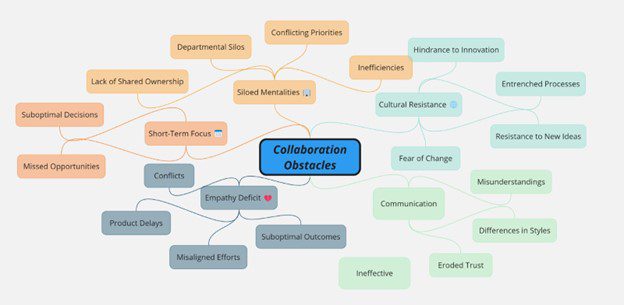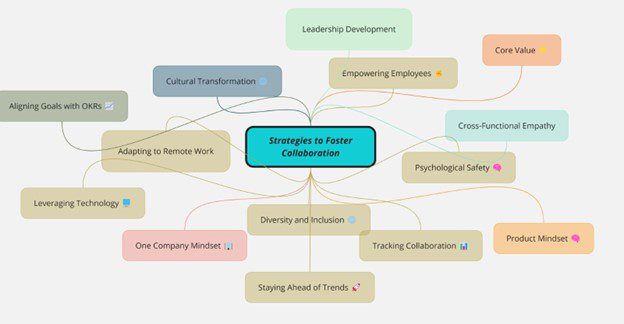In today’s fast-paced business world, success hinges on agility, innovation, and efficiency. As
the adage goes, “Collaboration is the new competitive advantage.” To thrive, organizations must
foster cross-functional collaboration by dismantling silos. While this concept is often discussed,
truly effective collaboration requires more than just buzzwords—it demands a cultural shift and
strategic implementation. My experience leading transformation for the past 10+ years across
multiple industry verticals reinforces the critical role of cross-departmental collaboration. It
became evident that overcoming entrenched departmental barriers was the key to driving
meaningful change.
Reflecting on my experience with TCF Bank, it became evident that driving transformation took
years, not months. We underestimated the resistance to change, and the time required to alter
long-entrenched habits and behaviors. Changing technology and platforms is necessary, but in
isolation, it wasn’t going to necessarily lead to different business results. This required us to
focus on collaboration. Collaboration required driving mindset shift and servant leadership, with
leaders acting as coaches, mentors, and developers, removing blocks, providing guidance, and
setting goals and context. Creating psychological safety and an empowered workforce truly was
essential to driving business value, growth, customer experience, and innovation. This not only
drove customer acquisition, but it also enabled the company to drive a merger of equals
seamlessly, doubling its asset class to a $50 billion merger.
Creating a Learning Environment
At TCF, we embraced a culture that prioritizes continuous learning and customer-centric
outcomes. We invested in development programs and initiatives like hack-a-thons. These
activities encouraged collaboration, knowledge sharing, and creative problem-solving, fostering
an environment where innovation and adaptability could thrive.
Embracing Outcome Over Activities
To truly embrace new ways of working, we engineered a mindset shift that focused on
outcomes rather than activities. By maturing a product framework in concert with an agile
methodology, business and technical teams were ready and able to work “arm in arm,” ensuring
they focused on the right things at the right time for the right reasons.
Shared Purpose: Collaboration vs. Competition
We focused on organization-wide benefits rather than single-use or single-department projects,
cultivating a culture of collaboration over competition. Establishing collaborative values,
behaviors, and beliefs across the organization fostered a shared purpose, ensuring that teams
worked together rather than against each other.
Securing a Seat at the Table
IT teams at TCF prepared for the future by building trust and credibility through understanding
business goals and aligning tech goals to deliver value. This proactive approach allowed IT to
secure a seat at the table as a business partner and advisor.
Conclusion: The Critical Role of Collaboration
In conclusion, collaboration is critical for driving successful transformation. By focusing on
people first, fostering a culture of empathy and empowerment, and ensuring that all
departments work together harmoniously, organizations can achieve meaningful and
sustainable change. The journey may be long and challenging, but with the right approach, it is
possible to overcome resistance and achieve remarkable results.
To succeed, organizations must become “non-destructive innovators,” balancing the need for
transformation with the preservation of core values, systems, and employee morale. While
technology is a powerful tool, it’s the human element—a collaborative culture—that truly propels
organizations forward. This article explores the strategies and benefits of effective crossfunctional teamwork, drawing on insights from industry leaders and my own experiences
Industry Benchmarks: Lessons from Leaders
While our journey at TCF was transformative, industry leaders like Apple, Amazon, and Google
set the gold standard for cross-functional collaboration. Their success stories underscore the
power of breaking down silos and harnessing the collective intelligence of diverse teams.
Apple’s iconic iPhone is a testament to the synergy between hardware, software, and design
teams. Amazon’s customer-centric approach relies heavily on cross-functional collaboration
across operations, technology, and marketing. Google’s innovation culture is fueled by the free
flow of ideas across departments.
These companies have demonstrated that cross-functional collaboration is not just a nice-tohave, but a necessity for long-term success.
Obstacles to Effective Collaboration

Effective collaboration is hindered by a myriad of challenges. Siloed mentalities, often
characterized as “isolated islands of expertise,” create barriers to information flow and shared
ownership. A lack of empathy between departments can further exacerbate these issues,
leading to misaligned efforts and suboptimal outcomes. Overcoming these obstacles requires a
concerted effort to break down these silos and foster a culture of understanding and
cooperation. These obstacles often manifest as:
Siloed Mentalities – A “not in my job description” attitude can create departmental silos, where
teams prioritize their own goals over the organization’s overall objectives. This can lead to
inefficiencies, duplication of efforts, and a lack of shared ownership. For instance, marketing
and sales teams may have conflicting priorities, hindering joint customer initiatives.
Empathy Deficit – A failure to understand and appreciate the perspectives of other departments
can result in misaligned efforts, conflicts, and suboptimal outcomes. For example, engineering
teams may prioritize technical feasibility over user experience, while design teams may focus on
aesthetics without considering functionality. This disconnect can lead to product delays and user
dissatisfaction.
Short-Term Focus – An excessive focus on short-term departmental wins can overshadow the
organization’s long-term goals. This myopic perspective can lead to suboptimal decisions and
missed opportunities for collaboration.
Cultural Resistance – Fear of change, entrenched processes, and a resistance to new ideas can stifle innovation and collaboration. A culture that values the status quo can hinder the adoption of new approaches and technologies. This can also be seen in finance departments prioritizing cost-cutting over revenue generation, hindering investments in innovation.
Communication Breakdown – Ineffective communication, including the use of jargon, unclear messaging, or lack of transparency, can create misunderstandings and erode trust. Differences in communication styles and preferences can also contribute to breakdowns in collaboration.
Addressing these challenges requires a concerted effort to foster a culture of collaboration, open communication, and shared ownership.
Strategies to Foster Collaboration

In an era of rapid change and increasing complexity, cross-departmental collaboration is no longer a luxury but a necessity. To unlock their full potential and thrive in the future, organizations must take deliberate steps to dismantle silos, foster trust, and leverage technology. To achieve this orchestral harmony, organizations must focus on –
Prioritizing Collaboration as a Core Value: Organizations must embed collaboration into their DNA by promoting a culture that values teamwork and shared goals. This can be achieved by recognizing and rewarding collaborative efforts, thus encouraging a more unified approach to achieving business objectives.
Embrace a “One Company” Mindset: Prioritize collective goals over departmental interests. For example, Apple fosters an ownership mentality, aligning all levels with the company’s strategic vision.
Cultural Transformation: Organizations must cultivate a culture that values diversity, inclusivity, and open communication. By challenging the status quo and encouraging new perspectives, companies can foster a more collaborative environment.
Fostering Cross-Functional Empathy: Implement job rotation and cross-training to enhance understanding and collaboration. Amazon’s initiatives expose employees to different business aspects, enhancing empathy and collaboration.
Aligning Goals with OKRs: To further enhance alignment and focus, organizations can adopt Objectives and Key Results (OKRs). Unlike traditional goals, OKRs are ambitious, measurable, and time-bound. By setting clear and challenging objectives, organizations can inspire teams to collaborate towards a common vision. For instance, a marketing and sales team might collaborate on an OKR focused on increasing customer acquisition by X% through a joint lead generation and nurturing campaign.
Product Mindset: Adopting a product mindset encourages teams to focus on delivering value to customers through collaboration. By aligning efforts around shared goals, organizations can break down silos and improve outcomes.
Investing in Leadership Development: Leaders play a crucial role in setting the tone for collaboration. By adopting servant leadership principles, leaders can create an environment where employees feel empowered to contribute. Continuous leadership development programs can help leaders develop the skills needed to foster a collaborative culture.
Empowering Employees: Empowering employees involves giving them the autonomy to make decisions and encouraging them to take initiative. When employees feel valued and trusted, they are more likely to engage in collaborative efforts and contribute innovative ideas.
Leveraging Technology: Technological tools are essential for facilitating effective collaboration. Investing in collaboration platforms, centralized data systems, and advanced analytics can enhance communication, streamline operations, and provide valuable insights that drive decision-making.
Measuring and Tracking Collaboration: Organizations should establish metrics to assess the effectiveness of their collaborative efforts. By tracking key performance indicators (KPIs) related to teamwork, innovation, and customer satisfaction, organizations can identify areas for improvement and celebrate collaborative successes.
Building Psychological Safety: Creating an environment where employees feel safe to express their ideas and take risks is critical for fostering innovation. Psychological safety encourages open dialogue, reduces fear of failure, and promotes a culture of continuous learning and improvement.
Adapting to Remote and Hybrid Work Models: The shift towards remote and hybrid work has changed the way teams collaborate. Organizations must invest in digital tools that facilitate virtual communication and teamwork, ensuring that all employees, regardless of location, can contribute effectively.
Embracing Diversity and Inclusion: Diverse teams bring a wide range of perspectives and ideas, driving creativity and innovation. Inclusive leadership practices ensure that all voices are heard and valued, creating a more dynamic and effective collaborative environment.
Staying Ahead of Future Trends: By keeping abreast of emerging trends such as AI integration, the experience economy, and data-driven decision-making, organizations can position themselves for success in the future of work.
Leveraging Technology to Bridge the Gap
Technology plays a crucial role in bridging the gap between departments and enhancing collaboration:
Key Technological Enablers
- Collaboration Platforms: Tools like Slack, Microsoft Teams, and Asana facilitate real-time communication, project management, and file sharing, fostering a connected and collaborative work environment.
- Centralized Data Systems: Ensuring all departments have access to the same information promotes alignment and reduces miscommunication.
- Advanced Analytics: Implementing data analytics and visualization tools helps identify trends, optimize processes, and inform decision-making.
- Continuous Improvement Platforms: Tools that support continuous improvement practices enable organizations to identify inefficiencies, gather feedback, and implement solutions.
- Virtual and Augmented Reality: These technologies create immersive collaborative experiences, especially for geographically dispersed teams.
- Data privacy is an essential consideration when fostering cross-departmental collaboration. As organizations increasingly rely on data to drive decision-making, it’s crucial to protect sensitive information while enabling data sharing between departments.
By strategically implementing these technologies, organizations can enhance communication, knowledge sharing, and overall collaboration.
Future Trends in Collaboration
The Rise of AI and Automation
- Augmented Collaboration: AI tools can facilitate information sharing, automate routine tasks, and provide insights to enhance human collaboration.
- Virtual Assistants: AI-powered virtual assistants can streamline communication, schedule meetings, and manage tasks, freeing employees to focus on higher-level collaboration.
Remote and Hybrid Work Environments
- Digital-First Collaboration: Organizations will increasingly rely on digital tools and platforms to connect geographically dispersed teams.
- Virtual Collaboration Tools: The demand for advanced video conferencing, virtual whiteboarding, and project management tools will grow.
- Culture Building: Companies will need to invest in fostering a strong company culture and sense of community among remote and hybrid teams.
The Experience Economy
- Customer-Centric Collaboration: Cross-functional teams will collaborate to create exceptional customer experiences across the entire customer journey.
- Data-Driven Collaboration: Organizations will leverage data analytics to gain deeper insights into customer behavior and preferences, informing collaborative decision-making.
The Road Ahead
In an era of rapid change and increasing complexity, cross-departmental collaboration is no longer a luxury but a necessity. By dismantling silos, fostering trust, and leveraging technology, organizations can unlock their full potential, drive innovation, and enhance customer satisfaction. While industry leaders have shown the way, the journey to a truly collaborative culture requires sustained effort and adaptation.
To embark on this collaborative journey, organizations must prioritize collaboration as a core value, invest in leadership development, empower employees, leverage technology, and measure progress. Creating a collaborative culture is like building a bridge between departments: it requires strong foundations, continuous maintenance, and a shared vision. By doing so, they can create a culture where innovation thrives, employees are engaged, and customers benefit from improved products and services.
Looking ahead, successful organizations will not only embrace collaboration but also anticipate its evolution in response to emerging trends like remote work, artificial intelligence, and data privacy. By proactively addressing these challenges and opportunities, businesses can position themselves as leaders in the collaborative economy.
Are you ready to transform your organization? The collaborative revolution starts now.
About the Author

Manisha Datye is an empowering technology executive passionate about enabling business transformation through technology and a customer-centric approach. Known for building highly effective multidisciplinary teams of diverse talent, she capitalizes on the strengths of each individual to ignite innovation. With a keen ability to see the big picture, challenge conventional wisdom, and build coalitions across organizations, Manisha encourages diversity of thought to drive meaningful change.
She excels as a member of leadership teams by fostering inclusive cultures and spearheading transformative initiatives. Passionate about aligning technology with strategic business objectives, Manisha enjoys mentoring, guiding, and collaborating to achieve success and innovation across organizations.
Connect with Manisha via LinkedIn or email.



